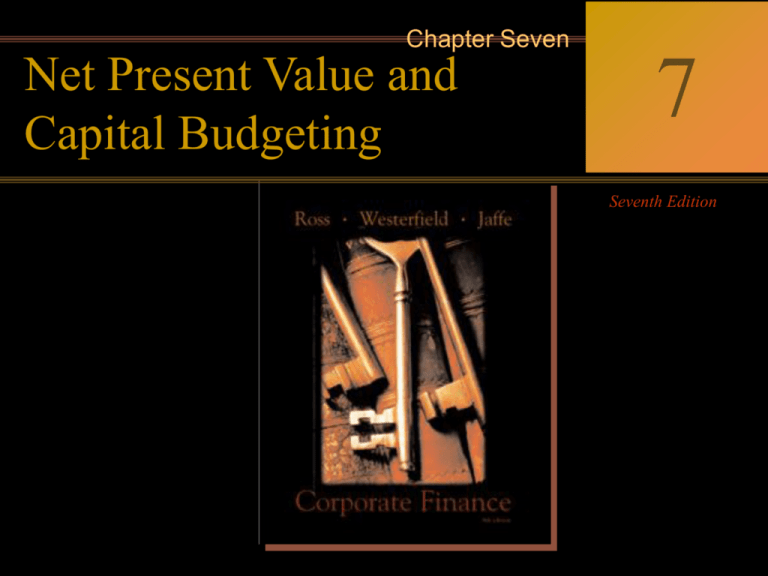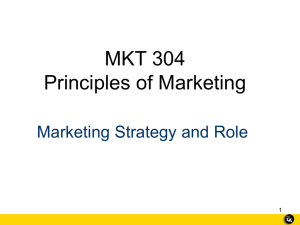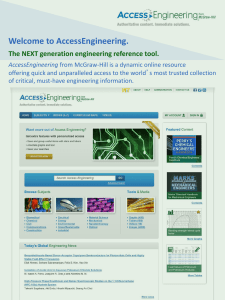
7-0
Chapter Seven
Net Present Value
andFinance
Corporate
Ross Westerfield Jaffe
Capital Budgeting
7
Seventh Edition
Seventh Edition
McGraw-Hill/Irwin
Copyright © 2004 by The McGraw-Hill Companies, Inc. All rights reserved.
7-1
Chapter Outline
7.1 Incremental Cash Flows
7.2 The Baldwin Company: An Example
7.3 The Boeing 777: A Real-World Example
7.4 Inflation and Capital Budgeting
7.5 Investments of Unequal Lives: The Equivalent
Annual Cost Method
7.6 Summary and Conclusions
McGraw-Hill/Irwin
Copyright © 2004 by The McGraw-Hill Companies, Inc. All rights reserved.
7-2
7.1 Incremental Cash Flows
•
•
•
•
•
•
Cash flows matter—not accounting earnings.
Sunk costs don’t matter.
Incremental cash flows matter.
Opportunity costs matter.
Side effects like cannibalism and erosion matter.
Taxes matter: we want incremental after-tax cash
flows.
• Inflation matters.
McGraw-Hill/Irwin
Copyright © 2004 by The McGraw-Hill Companies, Inc. All rights reserved.
7-3
Cash Flows—Not Accounting Earnings.
• Consider depreciation expense.
• You never write a check made out to “depreciation”.
• Much of the work in evaluating a project lies in
taking accounting numbers and generating cash
flows.
McGraw-Hill/Irwin
Copyright © 2004 by The McGraw-Hill Companies, Inc. All rights reserved.
7-4
Incremental Cash Flows
• Sunk costs are not relevant
– Just because “we have come this far” does not
mean that we should continue to throw good
money after bad.
• Opportunity costs do matter. Just because a project
has a positive NPV that does not mean that it should
also have automatic acceptance. Specifically if
another project with a higher NPV would have to be
passed up we should not proceed.
McGraw-Hill/Irwin
Copyright © 2004 by The McGraw-Hill Companies, Inc. All rights reserved.
7-5
Incremental Cash Flows
• Side effects matter.
– Erosion and cannibalism are both bad things. If
our new product causes existing customers to
demand less of current products, we need to
recognize that.
McGraw-Hill/Irwin
Copyright © 2004 by The McGraw-Hill Companies, Inc. All rights reserved.
7-6
Estimating Cash Flows
• Cash Flows from Operations
– Recall that:
Operating Cash Flow = EBIT – Taxes +
Depreciation
• Net Capital Spending
– Don’t forget salvage value (after tax, of course).
• Changes in Net Working Capital
– Recall that when the project winds down, we
enjoy a return of net working capital.
McGraw-Hill/Irwin
Copyright © 2004 by The McGraw-Hill Companies, Inc. All rights reserved.
7-7
Interest Expense
• Later chapters will deal with the impact that the
amount of debt that a firm has in its capital structure
has on firm value.
• For now, it’s enough to assume that the firm’s level
of debt (hence interest expense) is independent of
the project at hand.
McGraw-Hill/Irwin
Copyright © 2004 by The McGraw-Hill Companies, Inc. All rights reserved.
7-8
7.2 The Baldwin Company: An Example
Costs of test marketing (already spent): $250,000.
Current market value of proposed factory site (which we
own): $150,000.
Cost of bowling ball machine: $100,000 (depreciated
according to ACRS 5-year life).
Increase in net working capital: $10,000.
Production (in units) by year during 5-year life of the
machine: 5,000, 8,000, 12,000, 10,000, 6,000.
Price during first year is $20; price increases 2% per year
thereafter.
Production costs during first year are $10 per unit and
increase 10% per year thereafter.
Annual inflation rate: 5%
Working Capital: initially $10,000 changes with sales.
McGraw-Hill/Irwin
Copyright © 2004 by The McGraw-Hill Companies, Inc. All rights reserved.
7-9
The Worksheet for Cash Flows of the
Baldwin Company
($ thousands) (All cash flows occur at the end of the year.)
Year 0
Investments:
(1) Bowling ball machine
(2) Accumulated
depreciation
(3) Adjusted basis of
machine after
depreciation (end of year)
(4) Opportunity cost
(warehouse)
(5) Net working capital
(end of year)
(6) Change in net
working capital
(7) Total cash flow of–260.00
[(1) + (4) + (6)]
Year 1
Year 2
Year 3
Year 4
Year 5
21.76*
94.24
–100.00
80.00
20.00
52.00
71.20
82.72
48.00
28.80
17.28
5.76
–150.00
10.00
150.00
10.00
–10.00
–6.32
16.32
24.97
21.22
–6.32
–8.65
3.75
–8.65
3.75
0
21.22
192.98 investment
* We assume that the ending market value of the capital investment at year 5 is $30,000. Capital gain is the difference between
ending market value and adjusted basis of the machine. The adjusted basis is the original purchase price of the machine less
depreciation. The capital gain is $24,240 (= $30,000 – $5,760). We will assume the incremental corporate tax for Baldwin on
this project is 34 percent. Capital gains are now taxed at the ordinary income rate, so the capital gains tax due is $8,240 [0.34
($30,000 – $5,760)]. The after-tax salvage value is $30,000 – [0.34 ($30,000 – $5,760)] = 21,760.
Copyright © 2004 by The McGraw-Hill Companies, Inc. All rights reserved.
McGraw-Hill/Irwin
7-10
The Worksheet for Cash Flows of the
Baldwin Company
($ thousands) (All cash flows occur at the end of the year.)
Year 0
Investments:
(1) Bowling ball machine
(2) Accumulated
depreciation
(3) Adjusted basis of
machine after
depreciation (end of year)
(4) Opportunity cost
(warehouse)
(5) Net working capital
(end of year)
(6) Change in net
working capital
(7) Total cash flow of–260.00
[(1) + (4) + (6)]
Year 1
Year 2
Year 3
Year 4
Year 5
21.76*
94.24
–100.00
80.00
20.00
52.00
71.20
82.72
48.00
28.80
17.28
5.76
–150.00
10.00
150.00
10.00
–10.00
–6.32
16.32
24.97
21.22
–6.32
–8.65
3.75
–8.65
3.75
0
21.22
192.98 investment
At the end of the project, the warehouse is unencumbered, so we can sell it if we want to.
McGraw-Hill/Irwin
Copyright © 2004 by The McGraw-Hill Companies, Inc. All rights reserved.
7-11
The Worksheet for Cash Flows of the
Baldwin Company (continued)
($ thousands) (All cash flows occur at the end of the year.)
Year 0
Income:
(8) Sales Revenues
Year 1
Year 2
Year 3
Year 4
Year 5
100.00
163.00
249.72
212.20 129.90
Recall that production (in units) by year during 5-year life of the machine is
given by:
(5,000, 8,000, 12,000, 10,000, 6,000).
Price during first year is $20 and increases 2% per year thereafter.
Sales revenue in year 3 = 12,000×[$20×(1.02)2] = 12,000×$20.81 = $249,720.
McGraw-Hill/Irwin
Copyright © 2004 by The McGraw-Hill Companies, Inc. All rights reserved.
7-12
The Worksheet for Cash Flows of the
Baldwin Company (continued)
($ thousands) (All cash flows occur at the end of the year.)
Income:
(8) Sales Revenues
(9) Operating costs
Year 0
Year 1
Year 2
Year 3
Year 4
Year 5
50.00
100.00
88.00
163.00
145.20
249.72
212.20 129.90
133.10 87.84
Again, production (in units) by year during 5-year life of the machine is given
by:
(5,000, 8,000, 12,000, 10,000, 6,000).
Production costs during first year (per unit) are $10 and (increase 10% per
year thereafter).
Production costs in year 2 = 8,000×[$10×(1.10)1] = $88,000
McGraw-Hill/Irwin
Copyright © 2004 by The McGraw-Hill Companies, Inc. All rights reserved.
7-13
The Worksheet for Cash Flows of the
Baldwin Company (continued)
($ thousands) (All cash flows occur at the end of the year.)
Income:
(8) Sales Revenues
(9) Operating costs
(10) Depreciation
Year 0
Year 1
Year 2
Year 3
50.00
20.00
100.00
88.00
32.00
163.00
145.20
19.20
249.72
212.20 129.90
133.10 87.84
11.52 11.52
Depreciation is calculated using the Accelerated
Cost Recovery System (shown at right)
Our cost basis is $100,000
Depreciation charge in year 4
= $100,000×(.1152) = $11,520.
McGraw-Hill/Irwin
Year
1
2
3
4
5
6
Total
Year 4
Year 5
ACRS %
20.00%
32.00%
19.20%
11.52%
11.52%
5.76%
100.00%
Copyright © 2004 by The McGraw-Hill Companies, Inc. All rights reserved.
7-14
The Worksheet for Cash Flows of the
Baldwin Company (continued)
($ thousands) (All cash flows occur at the end of the year.)
Year 0
Income:
(8) Sales Revenues
(9) Operating costs
(10) Depreciation
(11) Income before taxes
[(8) – (9) - (10)]
(12) Tax at 34 percent
(13) Net Income
McGraw-Hill/Irwin
Year 1
Year 2
Year 3
Year 4
100.00
50.00
20.00
30.00
163.00
88.00
32.00
43.20
249.72
145.20
19.20
85.32
212.20 129.90
133.10 87.84
11.52 11.52
67.58 30.54
10.20
19.80
14.69
28.51
29.01
56.31
22.98
44.60
Year 5
10.38
20.16
Copyright © 2004 by The McGraw-Hill Companies, Inc. All rights reserved.
7-15
Incremental After Tax Cash Flows
of the Baldwin Company
Year 0
(1) Sales
Revenues
(2) Operating
costs
(3) Taxes
(4) OCF
(1) – (2) – (3)
(5) Total CF of
Investment
(6) IATCF
[(4) + (5)]
Year 1
Year 2
Year 3
Year 4
Year 5
$100.00
$163.00
$249.72
$212.20
$129.90
-50.00
-88.00
-145.20
133.10
-87.84
-10.20
-14.69
-29.01
-22.98
-10.38
39.80
60.51
75.51
56.12
31.68
–6.32
–8.65
3.75
192.98
54.19
66.86
59.87
224.66
–260.
–260.
39.80
$39.80 $54.19 $66.86 $59.87 $224.66
NPV $260
2
3
4
(1.10) (1.10) (1.10) (1.10)
(1.10)5
NPV $51,588.05
McGraw-Hill/Irwin
Copyright © 2004 by The McGraw-Hill Companies, Inc. All rights reserved.
7-16
NPV Baldwin Company
CF0
–260
CF1
39.80
F1
CF4
F4
F2
CF3
F3
McGraw-Hill/Irwin
1
1
CF5
CF2
59.87
224.66
54.19
F5
1
I
10
1
66.86
1
NPV
51,588.05
Copyright © 2004 by The McGraw-Hill Companies, Inc. All rights reserved.





